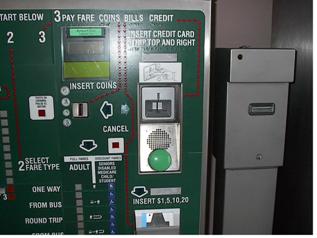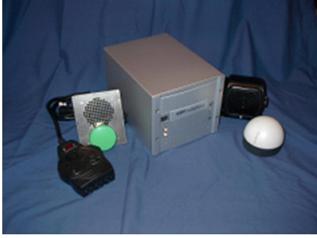|
The project addressed the difficulties that people with vision impairments encounter when they try to use most existing transit fare and ticket vending machines. The complex fare structures and operating mechanisms on many transit fare machines make it difficult to design and fabricate raised letter and Braille operating instructions that are independently usable by persons with vision impairments. Working collectively with the Tri-County Commuter Rail Authority (Tri-Rail) and the National Federation of the Blind (NFB), an audio device has been developed that can be programmed and installed on existing equipment to assist people with vision impairments to use these complex fare machines.
Project Results
The project consisted of three stages. Stage 1 documented the design and procurement process that was used to develop the tactile/visual instruction face plate for the existing Tri-Rail ticket vending machines. Extensive one-on-one testing with individuals who are blind or have vision impairments was undertaken to determine the usability of the existing tactile/visual instructions. During stage 2, the audio system, consisting primarily of a microprocessor, power supply, speaker, and response button, was designed and tailored to fit within the existing ticket vending machine cabinet. Audio instructions were composed and programmed to provide a question and response dialogue to make the ticket vending machine independently usable by persons with vision impairments. Initial responses from individuals with a broad range of vision impairments who were involved with the testing were very positive and provided insights on how the original design could be further improved before conducting additional testing to "fine tune" the text for the audio instructions. Stage 3 consisted of a three-month trial period where usability, reliability, maintainability, and overall patron acceptance was monitored. The results of the stage 3 testing of the equipment provided valuable insights into factors that must be considered to ensure that the equipment will be reliable and continue to function effectively in a range of environments.
Product Payoff Potential
The project demonstrated conclusively that the fabrication and installation of an audio instruction system, supplemented by a tactile instruction system, can greatly improve the usability of fare vending equipment by individuals with vision impairments. The project provides a blueprint for replication of these efforts. The project generated a user guide with two reports that will be useful to the transit industry. The first report documents a step-by-step
process illustrating how to design and procure usable tactile/visual instructional face plates for complex ticket vending machines. The second contains instructions on how to design, fabricate, and install a supplemental audio system on existing ticket vending machines and how to program concise, to-the-point audio instructions to effectively supplement the tactile/visual instructions. These products will show transit agencies how to make existing ticket vending machines independently usable by persons with vision impairments.
Product Transfer
The project was undertaken with the full collaboration and participation of the Tri-County Commuter Rail Authority and the National Federation of the Blind. The research has had successful results, in that patron acceptance has been positive and Tri-Rail took steps, even before the project was completed, to expand the use of the devices to more of its commuter rail stations. The original project plan called for four audio instruction devices to be installed and tested at four Tri-Rail stations. Tri-Rail, with assistance from the National Federation of the Blind, purchased six more devices which were installed at four additional commuter rail stations during the stage 3 evaluation period. There was positive feedback from the disability community. Elements of the audio instruction system, including the design and installation of tactile pathways and the creation of audio instructions keyed to the tactile pathways, have since been used on Maryland Transit Administration’s fare vending machines on their light rail transit system and Metro Subway transit system in Baltimore.
The project produced a final report, which documents the three stages of this project and the results of the project. A user guide provides step-by-step instructions describing how to design, fabricate, and install the necessary hardware and how to compose and program effective audio instructions to implement tactile and audio instructions that make existing fare vending equipment usable for persons with vision impairments.

Figure 1
Face of the Tri-Rail fare vending machine showing the large green audio response button and speaker grille unit installed on the right side of the face plate, just below the credit card insert slot.

Figure 2
Audio system hardware components, including, left to right, power surge protector, audio response button, and speaker grille, microprocessor cabinet, speaker, and audio amplifier/controller.
The final report for this IDEA project can be found at:
https://onlinepubs.trb.org/onlinepubs/archive/studies/idea/finalreports/transit/Transit29_Final_Report.pdf.
|
|